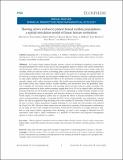Slowing down wolves to protect boreal caribou populations : a spatial simulation model of linear feature restoration
Abstract
In Canada, boreal caribou (Rangifer tarandus caribou) are declining in numbers, in part due to increased predation by wolves (Canis lupus). One management option to reduce wolf–caribou interactions and thus protect caribou is to remove man‐made linear features (LFs), structures such as roads, trails, and cut lines, which are used by wolves as traveling paths. Linear features increase wolf traveling speed and could additionally facilitate wolf entry into caribou habitat. Our goal was to quantify the expected effect of LF removal on caribou mortality and investigate whether this LF restoration could be a sufficient measure to stop caribou declines. We simulated the effects of LF restoration on caribou adult and calf survival in spatially explicit wolf–caribou encounter models. The models were parameterized using Global Positioning System (GPS) data, hidden Markov models (HMMs), and information from the published literature. Complete LF restoration decreased wolf traveling speed and thus reduced caribou mortality. The proportional reduction in adult caribou mortality ranged from 10 to 25% of its original value, and the proportional reduction in calf mortality ranged from 8 to 23%, depending on caribou density, number of wolf packs, kill probability given an encounter, and detection distance of wolves for caribou. Building on the model output, we used empirical caribou data to calculate the effects of reduced mortalities on the finite rate of annual population change, λ. Assuming that 25% or less of calf mortality was wolf‐related, λ stayed below one, that is, populations kept declining, even with complete LF restoration. With 50% of calf mortality due to wolves, caribou populations stopped declining ( λ≥1) if adult and calf mortality were reduced by at least 19 to 24%. However, these values were not achieved in a majority of the parameter combinations in our study, not even with complete LF restoration. Given that LF restoration as a single measure is unlikely to stop boreal caribou populations from declining, we used a case example to illustrate how LF restoration could make a small contribution in a portfolio of short‐term and long‐term management options to reduce wolf predation on caribou.
Citation
Spangenberg , M C , Serrouya , R , Dickie , M , DeMars , C A , Michelot , T , Boutin , S & Wittmann , M J 2019 , ' Slowing down wolves to protect boreal caribou populations : a spatial simulation model of linear feature restoration ' , Ecosphere , vol. 10 , no. 10 , e02904 . https://doi.org/10.1002/ecs2.2904
Publication
Ecosphere
Status
Peer reviewed
ISSN
2150-8925Type
Journal article
Collections
Items in the St Andrews Research Repository are protected by copyright, with all rights reserved, unless otherwise indicated.

